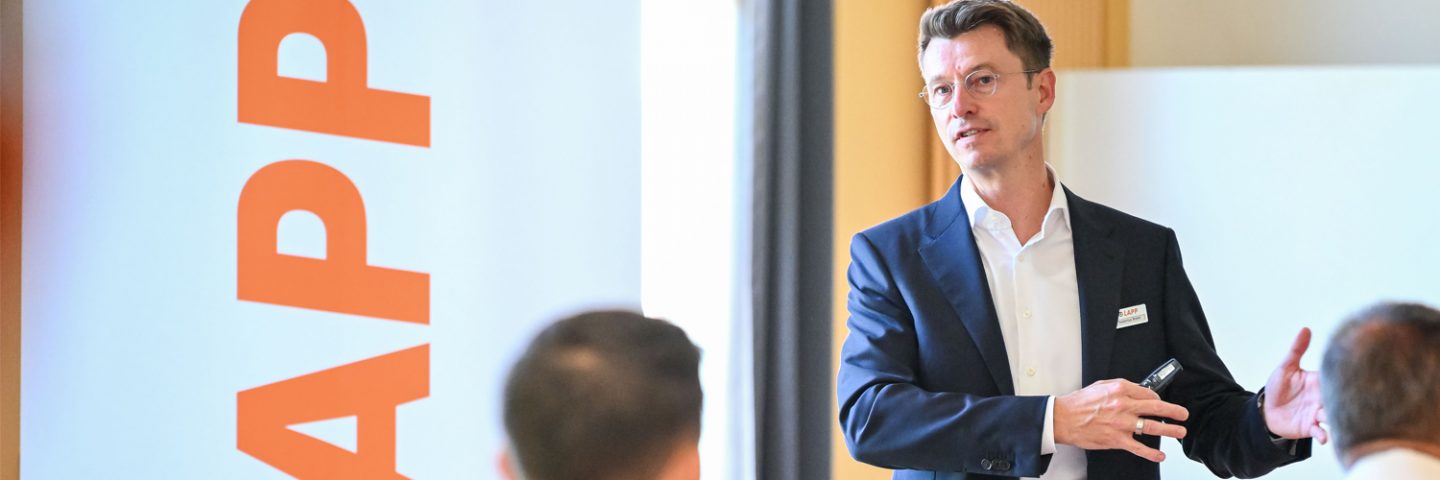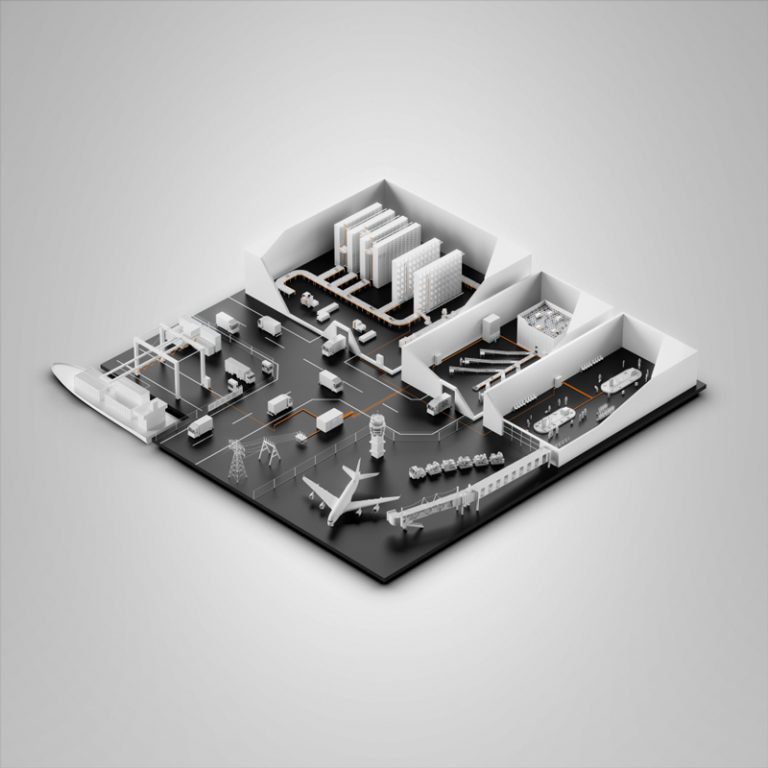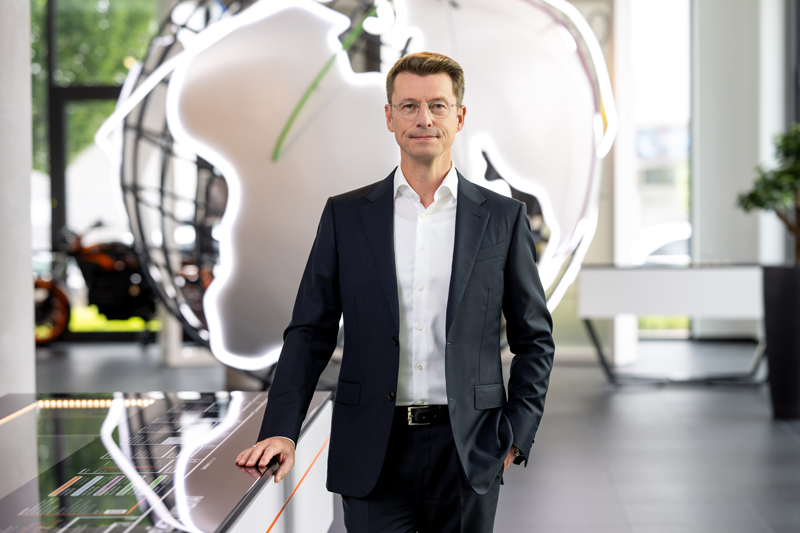
Forklifts glide between tall rows of shelves, robots sort packages every second, and conveyor belts stretching for miles transport goods through the halls without pause. In modern intralogistics, machines, data, and people work together to deliver products reliably and on time. Only when internal logistics run smoothly can companies remain competitive and thus successful in the long term.
However, the industry faces major challenges, including the ubiquitous shortage of skilled workers, global uncertainty, and volatile markets. “Intralogistics is one of the most dynamic areas of industry. To be successful here, you have to constantly rethink and redesign processes,” emphasizes Hubertus Breier, Chief Technology Officer (CTO) at LAPP.
The Stuttgart-based global market leader for integrated solutions in the field of cable and connection technology knows intralogistics from two perspectives: In its own operations, LAPP masters complex logistics processes worldwide on a daily basis and at the same time develops the technological basis for innovative intralogistics systems for other users. Practical knowledge flows directly into the development of new technologies and solutions. In this way, LAPP combines technological expertise with practical experience – and brings movement to an industry that is itself constantly on the move.
Where goods are stored, parcels travel, and luggage arrives
The increasing demands on intralogistics systems are evident in three areas: warehouses and distribution centers, mail and parcel sorting, and airport and freight logistics. In warehouses, the shortage of skilled workers is making automation a key strategy, and driverless transport systems and even humanoid robots are increasingly finding their way into warehouses. In high-frequency sorting centers, every second counts, which is why speed and real-time capability are in demand. Networked systems, precise sensor technology, and automated controls ensure that millions of shipments find their way. And in airport and freight logistics, baggage handling is confronted with just-in-time processes and acute staff shortages. Driverless transport vehicles and modular conveyor technology ensure smooth operations under high-load conditions.
To meet these challenges, the three technology levels of intelligent machines and devices, connectivity, and data and software must work together. Only when these levels are interlinked can they unleash their full innovative potential. LAPP derives leading industry trends from this, including autonomous driving systems and humanoid robotics, scalable and flexible storage systems, standardization and quick-connect solutions, as well as AI-supported forecasts and predictive delivery systems. LAPP already offers the right solutions for this today

1. Autonomous driving systems
Whether in high-bay warehouses, sorting centers, or cargo hubs, autonomous transport systems such as shuttles, automated guided vehicles (AGVs), or self-organizing storage systems are increasingly taking over internal material flow. They move independently through the halls, coordinate their routes, and thus increase efficiency and utilization. For these systems to work reliably, designs must be compact and at the same time efficiently networked. Added to this are short development cycles: new generations of vehicles requiring compatible solutions appear almost every year.
The collaboration between LAPP and a leading online retailer shows how this can be achieved. The retailer was looking for a partner for the development of its next generation of warehouse robots who could offer technical advice and flexibility in addition to components. Initially, the requirements were small quantities of prototypes, rapid response to design changes during the development process, and solutions for a highly complex connectivity design.
LAPP impressed with customized connection solutions and technical advice that went beyond standard services. Close cooperation between international teams shortened response times and enabled flexible adjustments to be implemented. The result: compact solutions that can withstand the dynamic movements of the bots and enabled a rapid market launch. Autonomous driving systems therefore offer enormous potential – provided the connectivity is right.
2.Humanoid robotics
Since the complete automation of warehouses is not immediately feasible, humanoid robots can serve as a bridge technology to counteract the shortage of skilled workers that is also noticeable in intralogistics. Warehouses and distribution centers are already short-staffed, and the work is physically demanding. Humanoid robots are built to resemble humans and can work in existing warehouse structures designed for people – without the need for costly renovations. There, they take on monotonous or physically demanding tasks such as lifting, carrying, or picking, thereby reducing the workload on staff.
LAPP supports the development of humanoid robots with the appropriate connection technology: hybrid cables combine power, signal, and data transmission in a single strand, saving space in the confined robot housing. Torsion cables withstand millions of bending cycles and rotation angles of ±360 degrees, making them ideal for the dynamic movements of humanoid robots. One example is the highly flexible UNITRONIC® data cable, which is already being used in a shoulder exoskeleton, where it permanently withstands the tight bending radius in the joint.
3. Scalable and flexible storage systems
The trend is shifting away from rigid systems with control cabinet devices toward modular and flexible structures. Operators expect systems that can be expanded, converted, or adapted without lengthy planning processes. In addition, systems should not only control, but also provide data required for analysis in edge systems or the cloud.
This is made possible by decentralized topologies with remote I/O that communicate via protocols such as IO-Link or PROFINET. Intelligent field modules are installed directly on the machine or conveyor system instead of laboriously routing each individual component to the control cabinet. This reduces installation costs and creates modular structures that can be quickly redesigned as needed.
More efficient cabling using daisy chaining also makes systems future-proof by allowing multiple drives or motors to be connected in series. Compared to star-shaped cabling, this saves material costs, reduces the space required in cable trays, and shortens installation times. This turns complex systems into flexible and future-proof systems.
4. Standardization and quick-connect systems
In addition to a flexible communication architecture, physical connectivity and connectability are also crucial for scalable warehouse structures to function. Systems must be designed so that they can be maintained or expanded during operation with virtually no downtime. Given the multitude of different, sometimes proprietary systems, there is a growing need for standardized connection solutions that reliably transmit energy and data.
LAPP offers a wide range of pluggable connection solutions that simplify the installation and maintenance of logistics systems and speed up retrofits. Flexible distribution boxes with quick-connect technology support modularity by enabling simplified integration into existing systems. LAPP offers its customers the right connector for a wide variety of applications and requirements.
In addition, pluggable patch cord solutions with pre-assembled cables and connectors can be connected directly, for example using push-pull technology, eliminating time-consuming stripping, crimping, or wiring. This significantly reduces installation time, which shortens commissioning even without specialized personnel. Connectivity thus becomes a key accelerator for innovation in intralogistics.
5. AI and predictive systems
Data is the lifeblood of modern business processes and is also indispensable in intralogistics. It must be accurately recorded and made usable in order to derive informed actions from information. This is exactly where LAPP comes in, developing solutions that allow data to flow seamlessly from the physical plant to the cloud, thus creating the basis for networked, predictive logistics.
One practical approach is LAPP eKanban digital cable inventory management. Inertial sensors with integrated IMU (inertial measurement unit) measure the rotations of the cable drums and thus determine the remaining lengths in real time. Companies receive accurate inventory data, can control replenishment according to demand, and avoid material bottlenecks and cost-intensive production interruptions before they occur. In combination with AI-supported applications, consumption patterns can be identified, demand can be forecast, and processes can be automatically adjusted. This increases efficiency, reduces costs, and creates significantly more planning security in dynamic logistics networks.

Dual role with added value
“LAPP is a technology provider and itself a user of sophisticated intralogistics solutions. This dual role gives us a deep understanding of what our customers really need,” emphasizes Hubertus Breier. “We know the challenges from our own experience and can therefore develop solutions that are practical and immediately usable.”
LAPP masters global delivery requirements through its own hub-and-spoke structure, among other things: Three internationally distributed hubs supply a network of regional logistics locations and ensure short response times, flexible adaptation to local markets, and high delivery reliability. “For customers, this means industry expertise, responsiveness, and proximity,” says Breier. “LAPP combines in-depth engineering know-how with a global presence to develop customized solutions, from individual connection components to integration into complex automation projects.”
The large number of partnerships also illustrates LAPP’s commitment to the industry: In close cooperation with customers and partners such as GEBHARDT Intralogistics Group GmbH & Co. KG, LAPP implements solutions ranging from standardized connection technologies to individually designed special cables.
Setting the course for the future
Intralogistics will continue to gain momentum in the coming years: greater automation, more networked systems, AI-supported decision-making processes, and even more flexible logistics structures will be the norm in the future. For companies, this means continuously rethinking their processes and consistently integrating technological innovations.
“Intralogistics will and must continue to undergo fundamental change,” says Hubertus Breier. “In the future, we will see systems that configure themselves, systems that network automatically, and processes that are controlled proactively thanks to real-time data and AI. Our goal at LAPP is to actively help shape these technologies so that our customers are at the forefront right from the start.”
LAPP is making it clear that the future of intralogistics is not something that will happen at some point in the future. It is starting now, with intelligent machines, smart connectivity, and data-driven solutions that are paving the way for a new era in logistics.
